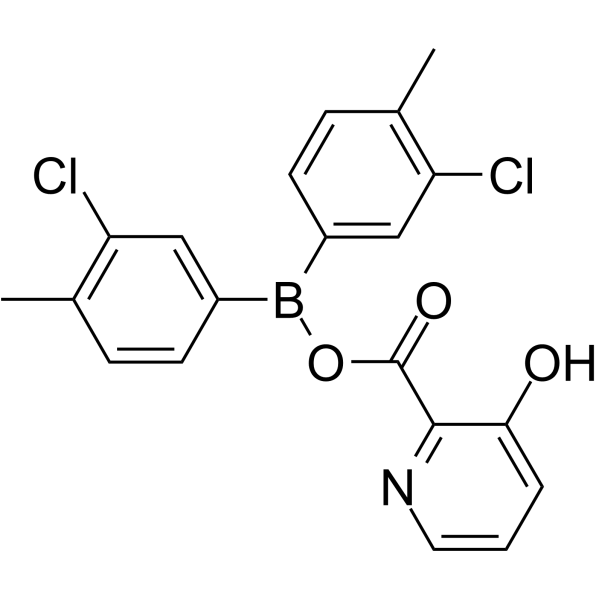872044-70-7
| Name | 2-Pyridinecarboxylic acid, 3-hydroxy-, anhydride with B,B-bis(3-chloro-4-methylphenyl)borinic acid |
|---|---|
| Synonyms | 2-Pyridinecarboxylic acid, 3-hydroxy-, anhydride with bis(3-chloro-4-methylphenyl)borinic acid |
| Description | AN0128 is a boron-containing antibacterial and anti-inflammatory agent. AN0128 against S. aureus, S. epidermidis, P. acnes, B. subtilis with minimum inhibitory concentration (MIC) values of 1, 0.5, 0.3, 1 μg/mL. AN0128 can be used for the research of periodontal disease and cutaneous diseases[1][2]. |
|---|---|
| Related Catalog | |
| In Vitro | AN0128 (compound 2g; 10 μM; 24-48 hours) shows strong inhibition of the release of pro-inflammatory cytokines (TNF-α, IL-1β) but no inhibition of IFN-γ or IL-4 release in human peripheral blood mononuclear cells (PBMCs)[1]. |
| In Vivo | AN0128 (1%, 5%; daily topical daub for 7 days) significantly reduces the formation of an inflammatory infiltrate and reduces bone loss[2]. Animal Model: Experimental periodontitis in twelve-week-old male Sprague-Dawley rats (weighing from 275 to 300 g each)[2] Dosage: 1% AN0128 in 40% Transcutol P, 40% PBS, and 20% ethanol vehicle Administration: Daily topical daub for 7 days Result: Similar to Ketorolac, resulting 50% and 35% increase in bone area and bone volume respectively, and 38%, 42% decrease in bone loss and inflammation respectively. Animal Model: Experimental periodontitis in twelve-week-old male Sprague-Dawley rats (weighing from 275 to 300 g each)[2] Dosage: 5% with Total toothpaste Administration: Applied daily via a cotton-tip applicator. for 7 days Result: Had more effect than Total toothpaste, resulting in a 33% increase in bone volume, and a 47% decrease in bone loss. |
| References |
| Molecular Formula | C20H16BCl2NO3 |
|---|---|
| Molecular Weight | 400.06300 |
| Exact Mass | 399.06000 |
| PSA | 59.42000 |
| LogP | 3.67350 |
